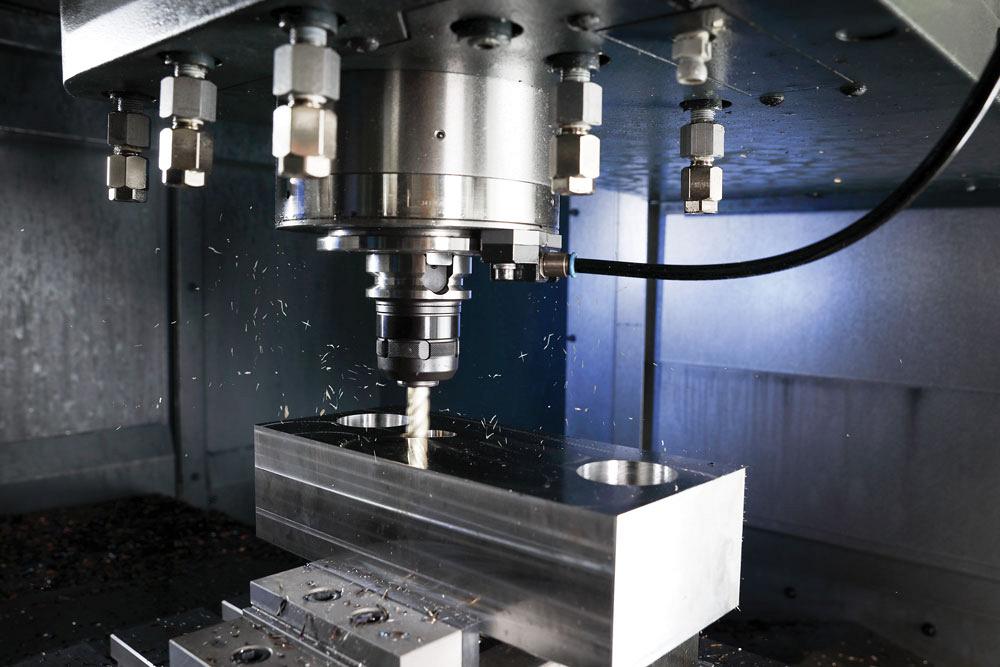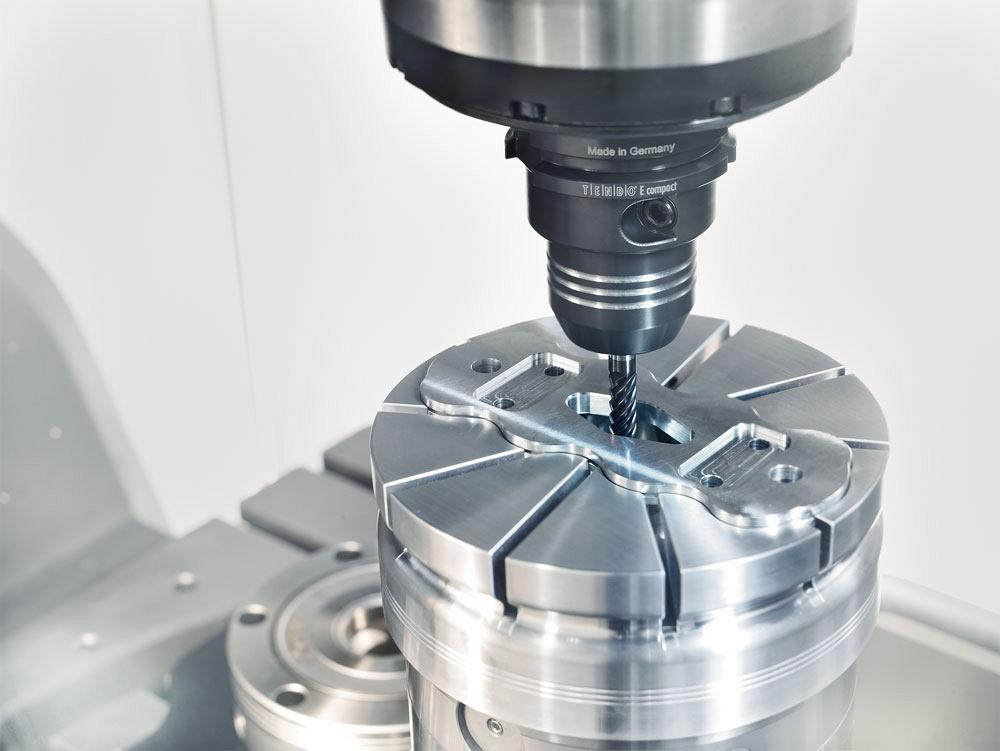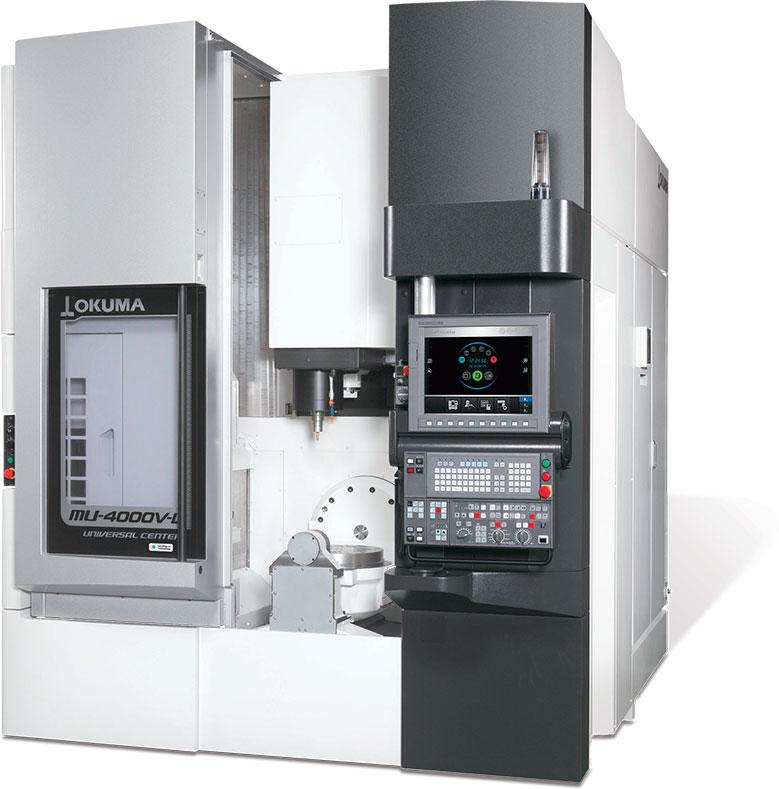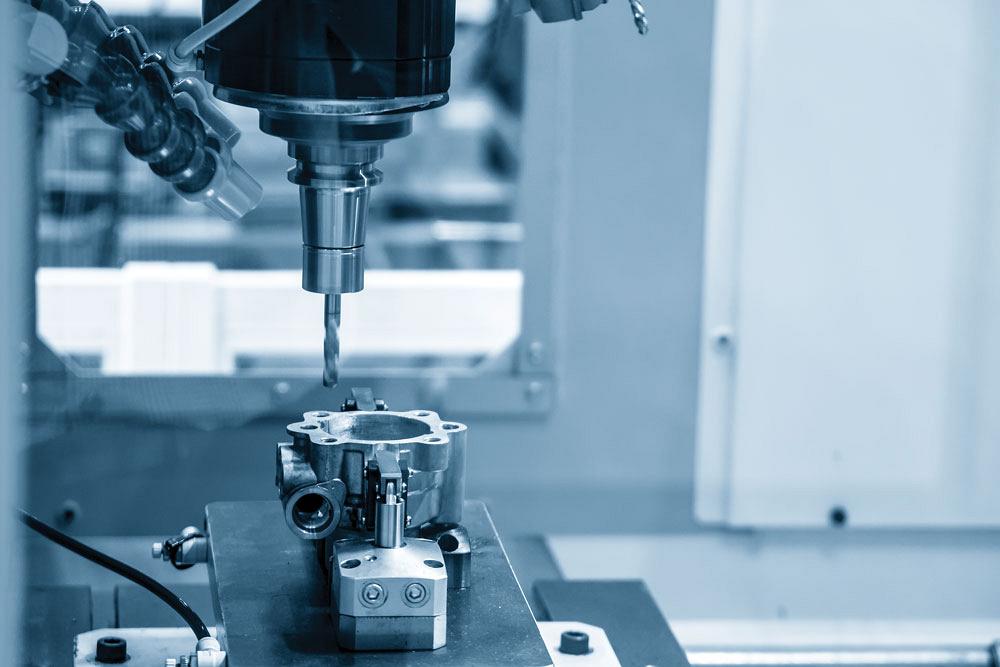Associate Editor
- FMA
- The Fabricator
- FABTECH
- Canadian Metalworking
More than just the drill
The machine, toolholding, and workholding can make or break holemaking operations
- By Lindsay Luminoso
- October 19, 2022
- Article
- Metalworking
While the drill is extremely important when it comes to producing good quality holes, there are other factors that can significantly impact the outcome. And when a hole is not meeting tolerance ranges or surface quality requirements, it’s important to look at the setup to see how to correct the situation.
Machine Tool Specifications
"Rigidity is very important for holemaking," said Trevor Smethurst, vice-president of applications and engineering, EMEC Machine Tools, Mississauga, Ont. "If you have vibration from the spindle, the table, the workholding, or the toolholder, it’s going to dramatically reduce the life of the drill and the quality of the hole. So rigidity is a key part of it."
From a machine perspective, it’s important to ensure that there is enough horsepower and torque to drive the drill at the recommended speeds and feeds. If there isn’t, then reducing the speeds and feeds may be required, which is not optimal.
"In my 40 years of machining, drilling has become one of the most advanced operations," said Smethurst. "Drilling has advanced so significantly over the years. But still some operators are slow to adapt and tend to run slower than what the drill and the machine are capable of, which causes rubbing and poor chip evacuation. If the chips start to get stuck down in the hole, it just causes premature tool wear. Not running the drills fast enough using the correct RPM or not feeding hard enough, this can have a detrimental effect to the drill."
Beyond horsepower and torque, a good strong spindle will help ensure good quality holes.
"Limiting runout of the spindle or the toolholder is important too, because runout will cause oversized conditions and reduce tool life," said Smethurst. "Some older machines may be getting a little tired and there can be wear on the spindle, and with even a little runout on the spindle, by the time it’s drilling, this runout at the spindle nose can translate to considerable runout at the drill tip."
Depending on the quality of the machine tool, wear can become more pronounced over time, whereas a high-quality machine can remain strong 20 to 30 years later.
"Before an issue arises, talk to your machine dealer, who in turn will have contacts with the tooling supplier, and attack it on a three-prong approach with the customer, the machine tool supplier, and tooling expert," said Smethurst. "This will allow shops to see if there are any gaps or places for improvement. Don’t just try and do it all by yourself. Use the resources available."
Auxiliary Attachments
For drilling on a milling machine, usually holes more than 2 mm dia., most of today’s machines have the necessary standard options and equipment to effectively produce a large or small quantity of holes.
"Most users are buying modern equipment that have spindle speeds in excess of 10,000 RPM, which is typically above what you normally need for drilling," said Jack Burley, president and COO, BIG DAISHOWA Inc., Hoffman Estates, Ill. "It’s not very often that you’re going to drill holes over 5,000 RPM when you get into larger sizes. And these machines have very good dynamic runout."

The BIG DAISHOWA Hi-Power Milling chucks’ thick wall body and high gripping force ensure high rigidity and stable performance. Fine and narrow slits in the body deform the clamping part properly to ensure even, strong gripping force and stable runout. BIG DAISHOWA
At higher speeds, even if its balanced, centrifugal force tries to move the tool out of centre. Higher precision machines tend to have higher accuracy when it comes to dynamic runout stability.
"If you run a machine at 10,000 RPM, instead of running on centre it might run orbitally," said Burley. "When you’re putting drills into that, which need to run concentric, even if you have a highly concentric balanced toolholder, it can still try to orbitally drill a hole, which is of course is going to give you an oversized hole, but it’s also going to give you negative effects such as bad surface quality and poor tool life."
Newer machines have found ways to deal with this, but when it comes to high-performance microdrilling on older legacy equipment, that can be a challenge.
"That’s where auxiliary attachments start to become more important," said Burley. "It’s not always about the need to run a machine or a drill at 50,000 or 70,000 RPM. You have to have some extremely small microholes to justify that. But an electric spindle or an air-driven spindle can function to replace the conventional machine spindle with its own spindle. So that means that the machine spindle never rotates."
A spindle attachment on the machine only moves up and down in the drilling cycle to Z axis. It does not rotate whatsoever. On legacy equipment with less than optimal runout conditions, especially dynamic runout conditions at higher speeds, these attachments remove all those from play.
"It removes factors that are going to influence high-quality drilling in the micro range," said Burley. "The electric or air-power spindle has its own spindle. And it’s been calibrated and designed to run at very high speeds with extremely low dynamic runout."
Using this auxiliary attachment does require a small modification to the spindle and how it mounts into the machine. For the most part, air-driven spindles are recommended for milling machines.
"An air-driven spindle is much easier to accommodate on a milling machine because you can turn the air on and off through the stop block with a simple M code function in the program," said Burley. "The tool can be automatically changed. The M code will turn the air on which turns on the tool, and then it’s just the opposite, turn it all back off. So that can be programmed and done automatically. It is an investment, and it might be hard to justify the cost outside of drilling a large number of small holes. But investing in one might give some shops an advantage taking on jobs, for example, in the semiconductor industry, which often looks for these attachments just by nature of the work they are expecting."
It’s important to qualify the current shop and machine condition. In some cases, with a good machine with decent RPM and coolant through tooling, it might make sense to opt out of the attachment. The gains in RPM don’t override the importance of through-tool coolant, especially for lots of small holes where flood coolant may not reach down to the cutting edge and chips can get jammed.
Burley noted that one misconception with microdrilling is that it requires ultra-high spindle speeds into the 80,000 RPM range. In certain applications and materials, high speeds do work better, but without good dynamic accuracy, it won’t work very well. Most companies that perform microdrilling can produce good holes at moderate speeds below 10,000 RPM.

When it comes to determining the best workholding options, Colin Frost noted that the type of workholding is far less important than properly calculating the necessary clamping force. Carr Lane Mfg.
Coolant Considerations
In holemaking applications, coolant is especially important. The type, concentration, and application all play a role in making successful holes.
"For deeper holes, good quality coolant is necessary," said Smethurst. "Through-tool coolant and high-pressure coolant are recommended, and 1,000 PSI is optimal. The concentration of the coolant is important. Most coolants are soluble oil and a lot of shops run 4 or 5 per cent, but some of these drills require 7 or 8 per cent oil concentration to get optimal conditions. Monitoring coolant will also ensure better process parameters."
With smaller holes and drills, coolant filtration is important. If particles get stuck down in the holes or in the hole of the drill, coolant may not be able to get to the drill tip. Filtration can limit the amount of particles that can plug the process.
Depending on the number of holes needing to be produced, it may be hard to justify certain coolant-related products. However, for shops working with lots of drilling applications, coolant monitoring and even coolant chillers might be a worthwhile investment.
Toolholding Stability
Good toolholding is key, and it can be an overlooked area when it comes to holemaking success.
"It’s so important to the entire process," said Smethurst. "You don’t want an ER32 collet; you’re better off with a hydraulic collet to get more rigidity in the tool. For extremely large holes, Big Plus is another good option."
The biggest factor in successful holemaking is runout. A hydraulic toolholder can limit the runout in ways that other toolholders cannot.
"For example, a SCHUNK hydraulic toolholder can offer a maximum runout of 3 μm," said Chris Fleurie, national sales manager- clamping group, SCHUNK Intec Corp., Mississauga, Ont. "A SCHUNK hydraulic bladder provides excellent vibrations dampening. So between those two features, you’re getting best hole performance and best tool life."
And while there are many different types of toolholders available, Fleurie cautions against using a side-lock toolholder. These holders will tend to decrease tool life significantly and create hole tolerance issues. The drill is constantly trying to fight itself to say in centre, and sidelock toolholders don’t provide the stability and runout conditions needed for good, tight-tolerance holes.
Most hydraulic toolholders also provide quick-change capabilities.

SCHUNK hydraulic chucks, like the TENDO E compact, are designed for machining processes that require high accuracy and can help ensure stability during drilling applications. SCHUNK
"Tool change is very simple with a SCHUNK hydraulic toolholder," said Fleurie. "It’s one set screw that can be loosened to change the tool, and once the new tool is in, the screw is tightened to a dead stop. It’s good to go at that point. The simplicity of this toolholder is a huge benefit. Some options also are very scalable, using a sleeve for different drill sizes. Oftentimes shops are still using some older technology and trying to produce quality holes, and they just can’t. This is where upgrading to a hydraulic toolholder from a current ER holder can be very successful."
Workholding
Effective workholding is important in holemaking to ensure hole quality and tool life. When workholding is ineffective, the workpiece can move, shift, or vibrate. When the workpiece moves or shifts, holes can be out of round or hole locations can be outside of their location tolerance.
"Vibration in the workpiece, which often manifests as chatter, can result in premature tool wear," said Colin Frost, president, Carr Lane Mfg. Co., St. Louis. "High-quality drills can be quite costly, which is why effective holding is necessary. New workholding should be a consideration whenever tools are not meeting or exceeding expected tool life. This is especially true if hole location and quality is failing to meet expectations. However, it’s important to note that most of these issues are caused by workpiece movement, not tool quality."
When it comes to determining the best workholding options, Frost noted that the type of workholding is far less important than properly calculating the necessary clamping force. Holemaking operations tend to apply a greater torque than other machining operations.
"These calculations can be difficult for shops to calculate," said Frost. "But a clamping force calculator can be used to find the proper size and make operations much easier for users."
For prismatic parts, shops have two primary workholding styles available: manually operated and power operated. The most significant determining factor is typically the number of workpieces to be produced. The higher the number of workpieces the more sense automation makes, and choosing a powered workholding device is the way to go.
"One common feature of holemaking workpieces is the need for that hole to be concentric to the outside of the workpiece," said Frost. "As the outside of the workpiece can vary, concentric requirements need specialty workholding. Some vises, in both powered and manual versions, can automatically align the centre of the workpiece to the centre of the vise, ensuring concentric hole formation."
Associate Editor Lindsay Luminoso can be reached at lluminoso@canadianmetalworking.com.
BIG DAISHOWA, www.bigdaishowa.com
Carr Lane Mfg. Co., www.carrlane.com

A machine tool that is both rigid and provides high accuracy, like this Okuma MU-4000V, will help ensure good quality holes during drilling operations. Okuma
EMEC Machine Tools, www.emecmt.com
SCHUNK, schunk.com
About the Author

Lindsay Luminoso
1154 Warden Avenue
Toronto, M1R 0A1 Canada
Lindsay Luminoso, associate editor, contributes to both Canadian Metalworking and Canadian Fabricating & Welding. She worked as an associate editor/web editor, at Canadian Metalworking from 2014-2016 and was most recently an associate editor at Design Engineering.
Luminoso has a bachelor of arts from Carleton University, a bachelor of education from Ottawa University, and a graduate certificate in book, magazine, and digital publishing from Centennial College.
subscribe now


Keep up to date with the latest news, events, and technology for all things metal from our pair of monthly magazines written specifically for Canadian manufacturers!
Start Your Free Subscription- Trending Articles
Sustainability Analyzer Tool helps users measure and reduce carbon footprint

Mitutoyo updates its end-user portal

Enhance surface finish with high-speed machining

Equispheres secures $20 million investment round

Solid carbide drills produce precision holes in short chipping materials

- Industry Events
Automate 2024
- May 6 - 9, 2024
- Chicago, IL
ANCA Open House
- May 7 - 8, 2024
- Wixom, MI
17th annual Joint Open House
- May 8 - 9, 2024
- Oakville and Mississauga, ON Canada
MME Saskatoon
- May 28, 2024
- Saskatoon, SK Canada
CME's Health & Safety Symposium for Manufacturers
- May 29, 2024
- Mississauga, ON Canada
















